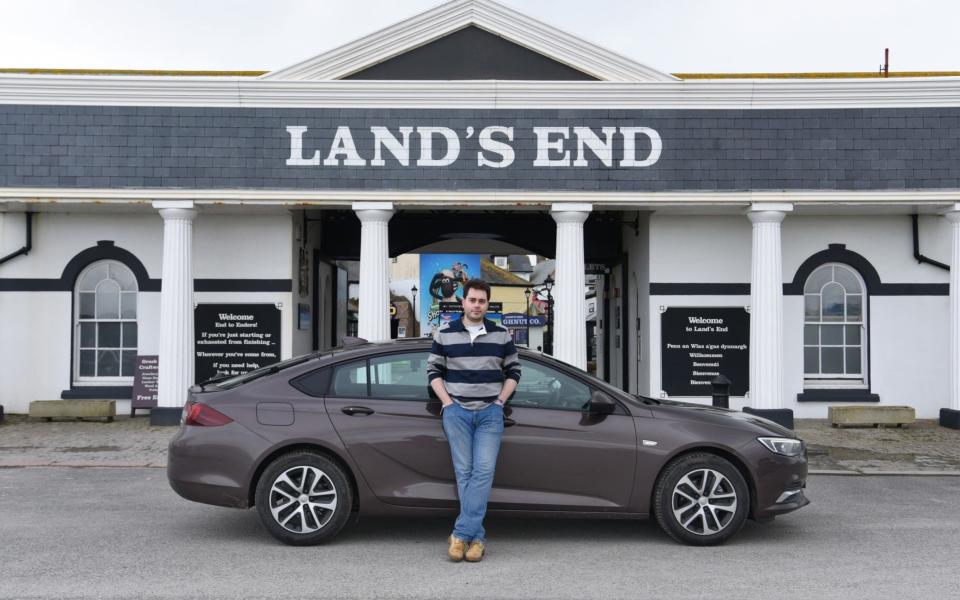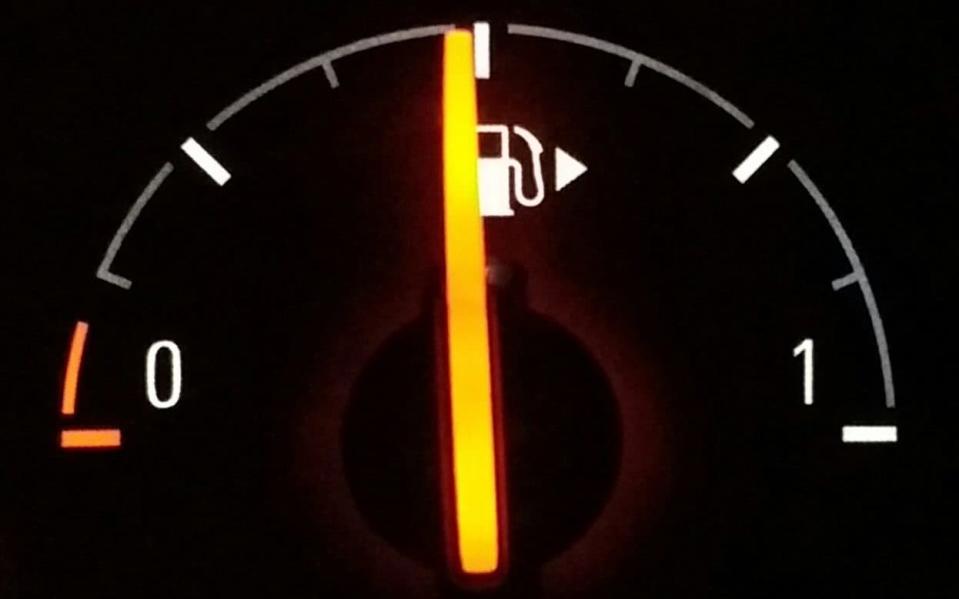Land's End to John O'Groats – on one tank of diesel

The hailstorm has abated, but frozen stones still weave down the fogged-up windscreen of my Vauxhall Insignia, the Atlantic’s squally gusts pressing hard against the car’s flanks. In my rear-view mirror I can see Longships Lighthouse; to my left I see Jay, a photographer, teetering on a small stepladder as he captures this profoundly British moment. The dashboard says 8° Celsius but the wind chill is bitter.

A freezing weekday morning in March is a bleak time to survey England’s most south-westerly extremity. The scenery is no less dramatic than it is in July but my desire to linger is markedly reduced. It’s the low season for the visitor centre here; apart from two friendly Cornish chaps cleaning the outside of the "Shaun the Sheep Experience", the place is practically deserted. I learn from a poster above the urinal that Land’s End is home to 220 species of flowering plant but most of them have yet to make an appearance in 2017. Land’s End in March is a cold, windswept place.

Thankfully I’ve come here with the intention of leaving immediately. I’m planning to drive to John O’Groats, around 850 miles away in Scotland, in the new 2017 Vauxhall Insignia. An easy task, but there’s a catch – I have to complete the journey on one tank of fuel.
I fill the car to the brim as best I can using a jerry can and frozen fingers, then ‘seal’ the filler cap with a Saint Piran’s flag sticker. I then wave farewell to Jay and the sea, and point my car at England.
Cornwall – A30
The A30 begins with a gentle bump as I leave the visitor centre and head inland. Outside holiday season, the dormant campsites and empty B&Bs make this road feel very remote – it’s easy to forget that the other end of the A30 has a McDonalds and a tube station.
According to the calculations I did in a fish and chip shop in Hayling the previous evening, this project will be a doddle. Provided I drive sensibly – which I always do – I should be able to average at least 65mpg. My 62-litre fuel tank accommodates around 14 gallons of fuel and that means I have a range of 910 miles, leaving me a comfortable 80-mile contingency.

But Cornwall conspires to slow me down. Rain, fog and a rogue winter caravanner keep my speed below 40mph until Bodmin, at which point roadworks reduce it to a crawl. It’s taken me two hours to get this far, but in addition to being behind schedule I’m also well below my efficiency target. I plan to make up for it on the M5, which starts around 60 miles away.
West country – M5
It’s taken four hours to reach the M5. During that time I’ve burned about a litre more diesel than I had planned to, which means that my behaviour between now and Birmingham needs to be even more thrifty. I’ve made a substantial dent in my ‘spare’ fuel already, and I haven’t even reached Somerset. It’s remarkable how easy it is to burn diesel, even when driving with fuel economy in mind. Just five minutes of stop-start traffic can undo an hour of careful throttle use, and a hundred yards of sliproad requires more fuel than a mile of motorway cruising.
Tucking into traditional Cornish lunch. I opted for a 'medium' pasty to save weight but it seems to have shed 2kg of crumbs into my footwell pic.twitter.com/pe3mKUVtO1
— Ed Wiseman (@edwisemanesq) March 22, 2017
The Vauxhall Insignia has shown itself to be a worthwhile companion so far. Its 1.6-litre engine produces a modest 108bhp with peak torque of 300Nm at 2,000rpm – not underpowered, but not exactly effortlessly wafty either. Keeping the fuel consumption low requires self control and forward planning.
I cross the Avon at a respectable 56mph. Last time I used this bridge I was in a Morgan Plus 4, occupying a very different part of the automotive landscape in terms of comfort, practicality and warmth. It’s nowhere near as fun but, as I pass Worcester and head towards Birmingham at 4pm – just in time for rush hour – I’m grateful that the Insignia has a roof and doors.
The north – M6
My car, while good, has begun to grate a little. The relentless drone of motorway driving is more pronounced in the Vauxhall than in its German rivals, but perhaps most annoying is the touchscreen. It presses buttons for me, seemingly at random, muting phone calls or cancelling satellite navigation routes unpredictably. This pre-production car is only a thousand miles old so I hope they get it sorted.
The sat nav keeps randomly changing the map, zooming in/out, and trying to cancel the route. Unusable. Thankfully I know where Scotland is. pic.twitter.com/1bHIJo9DjR
— Ed Wiseman (@edwisemanesq) March 22, 2017
The M6 crosses Watling Street after a couple of minutes. This is the second time Britain’s longest motorway crosses one of its oldest routes, the first being way back at the source of the M6 near Rugby. It runs near some of England’s most famous towns and cities – Stafford, Stoke-on-Trent, Manchester, Liverpool, Preston and Lancaster, before nuzzling its way between the Lake District and the Yorkshire Dales. The point at which these two national parks almost touch, on the banks of the River Lune, represents my half-way point.

I stop at Tebay services for a much-needed coffee and a celebratory sausage roll. An hour later, after a brief delay near Carlisle, I cross the Sark near Gretna, waving goodbye as I do so to Cumbria, England and – at long last – the M6.
Caledonia – A74M, M74, M80...
Apart from a 10-foot saltire bidding me fàilte, there’s little fanfare upon entering Dumfries and Galloway by road. The M74 is actually the A74M at this point, a distinction that matters to few and interests fewer, but either way the road itself is not unlike any other stretch of motorway on the British Isles.

What’s changed is the scenery. The A74M loosely follows Kirtle Water, the River Annan, Evan Water and then finally the Clyde, which makes for a meandering route to Glasgow. It’s one of my favourite British cities, even if it can be fiendishly complicated to navigate by road. Even the motorway route (which is currently being variously dug up and tinkered with) is baffling in parts – I can’t afford a detour at this point.
All these roadworks have been a mixed blessing. Being able to hum along at 50mph makes for efficient, relaxing motoring, and it’s immensely satisfying to watch my average MPG figure rise. On the other hand, 50mph zones seem to cause traffic, as well as unpredictable slowdowns while one lorry driving at 49.98mph attempts to overtake another lorry driving at 49.72mph. As the motorway narrows from three lanes to two, before turning into A-road near Dunblane, I begin to seriously worry.
Highlands – A9
I leave Inverness at dawn, just in time to watch the sun rise over the Moray Firth. Oil rigs and their associated hardware form an odd procession through this stretch of water, their enormity completely unclear from my vantage point on the shore. The fuel warning light comes on as I cross the Cromarty Firth, with 120 miles to go. I can relax – there’s no way I’ll be able to make it another 120 miles on the reserve. There’s still the best part of a gallon of DERV in a jerry can in the boot, so when the car conks out I’ll be able to top it up.
The A9 is one of the prettiest routes in Britain. From the Dornoch Bridge northwards it hugs the coast, linking countless little settlements that face into the freezing North Sea wind. The sun has risen and warmed the air. This will be a splendid place to break down.
6.9 miles to John O'Groats. Decimals are reassuring; warning lights are not. My parched car soldiers on. Also, the sea: pic.twitter.com/tPfdzXkHar
— Ed Wiseman (@edwisemanesq) March 23, 2017
But by Wick, my parched car shows no signs of slowing. The fuel warning light changes from static to flashing, then back to static again, and the dashboard’s plaintive messages switch from plaintive to officious. The map on the sat nav screen is still useless, but the miles to my destination fall to single figures.
The home straight – A99
I drop the clutch. I refuse to be defeated on the final half-mile, which thankfully is perfectly straight and slopes gently towards my destination. There’s nobody around to see my filthy Vauxhall, painted brown to begin with but now browner still thanks to 850 miles and countless wintry shires. I allow myself one final squeeze of the accelerator.
The visitor centre has just opened. Coast to coast, gift shop to gift shop. I’ve eaten six meals in the Insignia over the past couple of days, three of them hot, so I purchase a Loch Ness monster air freshener in an attempt to bring some normalcy to its smellscape.
I applied this sticker in a Cornish hailstorm and took it off in Scottish sunshine, a day and 865 miles later... That'll do, 'Sig. pic.twitter.com/meWGz4z6ui
— Ed Wiseman (@edwisemanesq) March 23, 2017
I peel back the Saint Piran’s flag from my fuel filler cap. I’m surprised it’s held, given that it was applied to a diesel-soaked surface during a hailstorm. In contrast, Scotland is almost summery.
I’d stay and explore if Vauxhall didn't need its car back. But as warm sun soaks the stony Caithness coastline and mainland Britain stretches out in front of me, I realise that the journey home was always going to be the highlight of this trip – heading south, I can take the scenic route.
#FridayFeeling feat. Scotland (Insignia mix) pic.twitter.com/RNpWE5H0CF
— Ed Wiseman (@edwisemanesq) March 24, 2017
For more tips and advice, visit our Advice section, or sign up to our newsletter here


